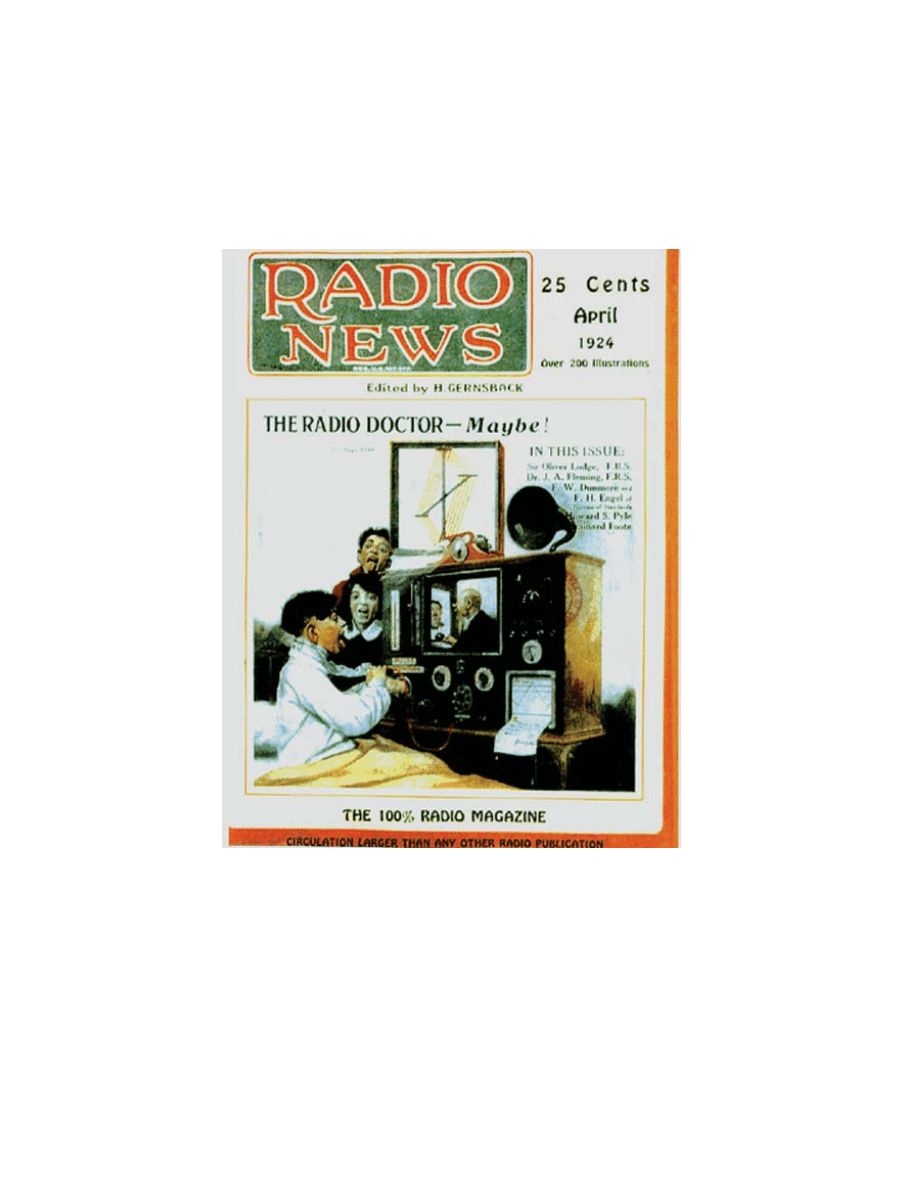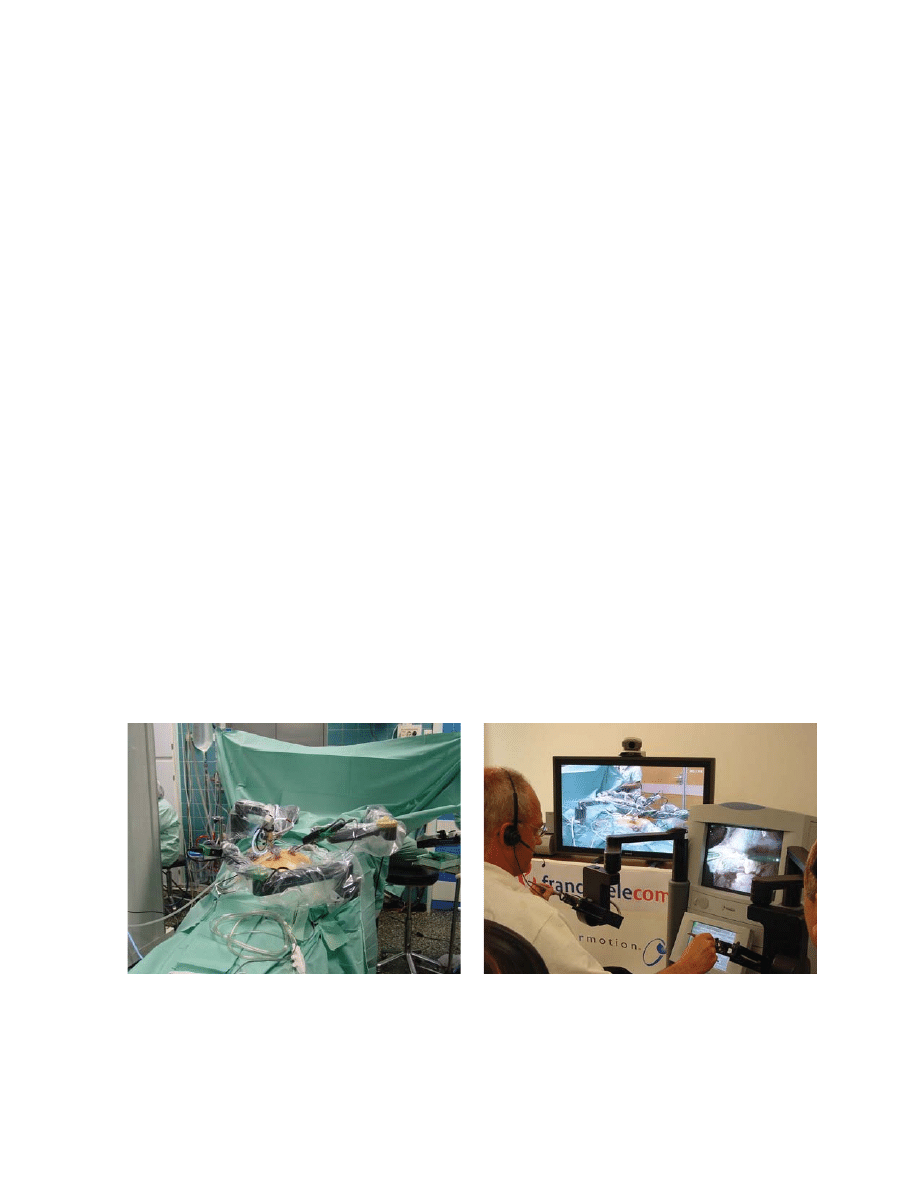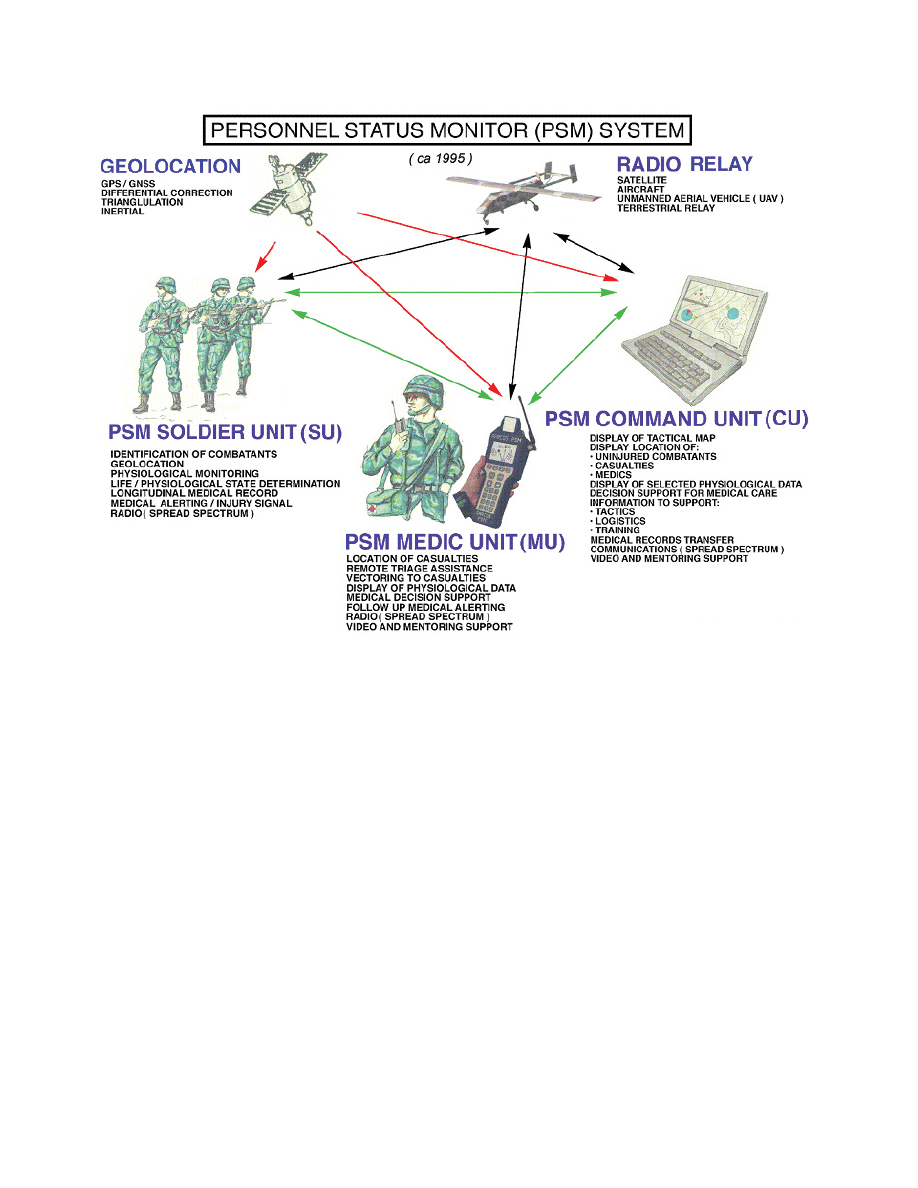
A Look Toward the Future
831
Chapter 26
A LOOK TOWARD THE FUTURE
THOMAS E. BEAM, MD*;
AND
EDMUND G. HOWE, MD, JD
†
INTRODUCTION
FUTURE ISSUES AFFECTING POLICY
Nonlethal Weapons
“Bloodless War”
FUTURE ISSUES AFFECTING INDIVIDUALS
Telemedicine/Telepresence Surgery
Pharmacological Optimization for the Battlefield
Lazarus Project
CONCLUSION
*Colonel (Retired), Medical Corps, United States Army; formerly, Director, Borden Institute, Walter Reed Army Medical Center, Washington,
DC 20307-5001 and Medical Ethics Consultant to The Surgeon General, United States Army; formerly, Director, Operating Room, 28th
Combat Support Hospital (deployed to Saudi Arabia and Iraq, Persian Gulf War)
†
Formerly Major, Medical Corps, United States Army; currently, Director, Programs in Ethics, Professor of Psychiatry, and Associate Profes-
sor of Medicine, Uniformed Services University of the Health Sciences, 4301 Jones Bridge Road, Bethesda, Maryland 20814; and Chair,
Committee of Department of Defense Ethics Consultants to the Surgeons General

Military Medical Ethics, Volume 2
832
Nothing New Under the Sun. As this somewhat humorous depiction from 1924 shows, telemedicine has been a fasci-
nating application of technology for many decades. This concept is a reasonably accurate depiction of some
telemedicine applications today. One can only wonder how many of the futuristic concepts explored in this chapter
will become standard medical practice in the future.

A Look Toward the Future
833
INTRODUCTION
dia, by enhancing this expectation when it is unre-
alistic, may be working against the military and
greater society’s ultimate interest. Yet, because the
military does and should represent and carry out
society’s will, society should have as much access
to updated information through the media as is
practicable. Thus, there is a present and ever-in-
creasing ethical dilemma in regard to how these
conflicting interests should be resolved.
In the second section, we will discuss telemedicine
and telepresence surgery, the use of drugs to en-
hance soldier’s performance, and the use of new
potentially lifesaving techniques not yet fully tested
to save their lives during combat. The new tech-
nologies involving telemedicine raise such issues
as when these technologies should be employed and
this in turn involves such questions as how their
use will affect soldiers’ morale. The use of drugs
such as short-acting sleep medications is already
being tested to enhance soldiers’ performance and
welfare on the battlefield. The use of other drugs
before combat has not been carried out but as new
drugs are developed, this may be readdressed. New
treatments not fully tested are already being con-
sidered on “compassionate grounds” for battlefield
use, but appropriate procedures have not yet been
developed to protect soldiers optimally from un-
known, potential harms of new but not fully tested
treatments while allowing them to have the ben-
efits from them.
In this second volume of the Military Medical Eth-
ics textbook, we have examined the historical di-
lemmas associated with practicing medicine in the
military. These include some of the travesties that
can occur when priorities become unbalanced. We
have looked at some of the current checks and bal-
ances in the United States military. In this chapter we
will look to the future. This chapter will examine sev-
eral possible future scenarios and attempt to estab-
lish for each a starting point for their ethical analysis.
Physicians in the military will always face ethi-
cal issues. As technology continues to improve in
the future, there will be new challenges. Some of
the unique issues and ethical dilemmas associated
with them are evident today. It is likely that there
will be issues that require new paradigms for con-
ducting ethical analyses. Some examples are meth-
ods of warfare designed to reduce human suffer-
ing and new technologies developed to enhance the
health and well-being of the soldier.
This chapter will be divided into two sections.
The first will involve policies. The first issue is the
one just noted above—policies regarding nonlethal
weaponry. This new technology possibly raises the
need for a new analytic paradigm because the ef-
fects of this weaponry are the opposite of the weap-
onry usually used. The second issue is policy re-
garding the media. Here, because new technologies,
such as precision-targeted bombing, may lead to
societal expectations of a “bloodless war,” the me-
FUTURE ISSUES AFFECTING POLICY
A large organization such as the military faces
many issues that require policy decisions. Policy
decisions, and their ethical analyses, are analogous
to those now being pursued in the rapidly devel-
oping field of organizational ethics in civilian medi-
cal contexts. In this chapter we will focus on two
issues requiring policies: (1) nonlethal weapons and
(2) “bloodless war.”
Nonlethal Weapons
The Geneva Conventions were developed in an
effort to fight wars more “humanely” (see Chapter
23, Military Medicine in War: The Geneva Conven-
tions Today). Weapons that cause indiscriminate
and unnecessary suffering are banned.
1,2
The just
war principle of discrimination requires using the
least force necessary to accomplish the mission (as
discussed in Chapter 8, Just War Doctrine and the
International Law of War). Several new technolo-
gies that attempt to limit the lethality of weapons
are currently being evaluated to attempt to decrease
the human toll of wars and operations other than
war.
3
These devices are also being examined for use
by civilian police forces.
4,5
There are agents that stun
opponents, using electricity, light, or sounds. Pro-
jectiles can be developed that have less kinetic en-
ergy or are made of different materials than those
currently used that cause permanent injury or
death. There are agents that can immobilize an en-
emy—such as glues, nets, and foams. Chemical ir-
ritants or other chemical or mechanical agents also
can decrease the enemy’s will to fight. Some of these
weapons were deployed to Somalia with the US
Marines who safeguarded the withdrawal of the
remaining United Nations (UN) peacekeepers.
6,7
Of
them, the Marines actually used slippery foam to
attempt to control looters.
8
In civilian contexts just
the knowledge that these weapons exist and will
be used more freely than lethal force has reduced

Military Medical Ethics, Volume 2
834
the number of times they are needed (ie, the threat
of their use can be a deterrent).
9
Medical ethical decisions are inherent in how
physicians become involved in developing the tech-
nologies discussed above. Physicians could help
determine thresholds beyond which the weapons
have a higher likelihood of causing death or per-
manent injury.
10,11
Physicians could also, by using
their knowledge of physiology and anatomy, help
develop more efficient weapons. The core ethical
question these possibilities pose is whether physi-
cians should participate in developing these weap-
ons. The Geneva Conventions leave this question
unanswered. Several statements in the Geneva Con-
ventions suggest that physicians should not use
their medical knowledge for anything other than
the best medical interests of their patients.
12
How-
ever, the Geneva Conventions have been interpreted
to apply only on the battlefield and to have no le-
gal force concerning weapons development prior
to war or in a site distant from the battle.
13
If these newly developed weapons were intended
to not be lethal, their use would cause less death
and disability than current methods of warfare. In-
numerable persons could benefit. Therefore, ethi-
cally, on this ground, it would be beneficial for phy-
sicians to help develop this weaponry. Doing so
could be a further step towards a more humane war.
From the standpoint of the just war concept of pro-
portionality (using only those weapons whose
harms are necessary), physicians’ roles in develop-
ing these weapons might be not only justifiable but
also mandatory. As John Courtney Murray states,
“Force is the measure of power necessary and suf-
ficient to uphold the valid purposes of law and of
politics. What exceeds this measure is violence
which destroys the order both of law and of
politics.”
14(p208)
In addition to benefiting soldiers by not harm-
ing them excessively, the value this would further
is utility (see Chapter 2, Theories of Medical Eth-
ics: The Philosophical Structure). The greatest good
for the greatest number would be gained by using
(and developing) less than lethal weapons. From
the perspective of these two values being furthered,
doctors participating in this research would be jus-
tifiable. Dr. Knut Krieger, a scientist working on
chemical and biological weapons stated, “if we do
indeed succeed in creating incapacitating systems
and are able to substitute incapacitation for death
it appears to me that next to stopping war, this
would be an important step forward.”
15(p315)
Of
course, the converse argument has also been ad-
vanced, namely, scientists’ involvement in devel-
oping weapons that are even more lethal can pre-
vent war and therefore produce an overall good.
Albert Nobel, the inventor of dynamite, said in 1892
that “on the day that two army corps can mutually
annihilate each other in a second, all civilized na-
tions will surely recoil with horror and disband their
troops.”
16(p19)
However, although this could occur
in theory, past history would suggest this is wholly
implausible. The availability of nuclear weapons is,
perhaps, a case in point.
The foremost argument against physicians, in-
cluding military physicians, participating in re-
search to develop weapons is that the physician is
to use his medical knowledge only for the good of
his patient. The Hippocratic writings and other codes
of medical ethics describe this concept. Clearly
people will suffer, at least temporarily, by having
these weapons used on them. Thus, although in a
relative sense, physicians doing this research would
save lives, in an absolute sense, they are contribut-
ing to potential injury and death.
Some argue that the Hippocratic Oath, which
proscribes causing suffering,
17
is only in force within
the limited confines of the patient–physician rela-
tionship.
13
However, this claim fails to successfully
negate the promise physicians make to their pa-
tients at large when becoming physicians. This
promise is the major ethical value against physi-
cians participating in developing weapons, includ-
ing nonlethal weapons.
This promise gives the physician overarching
responsibility toward patients in part because the
greater society allows him exclusive privileges, such
as dissecting a human cadaver during training.
(This concept was discussed more fully in Chapter
1, The Moral Foundations of the Patient–Physician
Relationship.) How then should these chief conflict-
ing values, saving lives and physicians keeping
their implicit promise to heal and not harm, be bal-
anced or should they be balanced at all? There is a
point at which a physician participating in a poten-
tially evil practice becomes unconscionable, even
if his intentions are to help. For example, society
expects physicians not to participate in developing
torture techniques, even though their assistance
could prevent loss of life. Physicians’ participating
in torture seems well beyond this point and there-
fore would be ethically impermissible regardless of
possible benefit. Use of less than lethal weapons,
as opposed to the use of torture, may or may not be
enough of a harmful action that physicians ethically
shouldn’t participate in developing them.
Discerning what will maximize the overall good
is another concern. Currently the use of force, le-

A Look Toward the Future
835
thal or less than lethal, is usually thought to be a
measure of last resort. Thus it is, or should be, pre-
sumed that all measures short of force should be
exhausted before resorting to force. Yet, if less than
lethal weapons are readily available, and if their use
consistently avoids killing or permanently injuring
people, it may be more likely that they will be
used.
18
The threshold for use might be relaxed dra-
matically to allow earlier use of these weapons,
without attempting to resolve conflict in ways that
do not use force. Even if these weapons are rela-
tively “safe,” using them could cause suffering and
more frequent use could actually result in an over-
all increased net harm to people.
Physician participation may be proscribed for yet
another reason. When dose response curves for
medications being developed are generated, there
is an endpoint beyond pure therapeutic effective-
ness. Safety studies of new drugs demonstrate this.
When a new drug is evaluated for safety and effec-
tiveness, gradually increasing doses are used to
identify the point of maximum effect without in-
creasing unwanted effects as well. Because side ef-
fects occur with all medications, the point at which
they are expected to arise must be determined and
therapeutic doses must remain below this. For less
than lethal weapons the same concept applies. Phy-
sicians could determine the maximum “safe” dose
of electricity, or sound, or light to cause the opti-
mal desired effect without killing or permanently
harming the person. By determining this point,
however, lethal or permanently disabling weapons
(that exceed the “safe” dose) could be developed
by using the physician’s data, even though this
would be contrary to his intention. For example,
finding a “safe” dose for laser weapons (ie, one that
will not permanently blind) will determine, con-
comitantly, the dosage that would be blinding.
This potential risk is analogous to the one arising
in physician participation in research “primarily”
directed at defensive measures against biological
weapons (discussed in Chapter 18, Medical Ethics
in Military Biomedical Research). Although the
physician may intend his data to be used only to
improve defensive measures, the same data could
quite effectively be used to improve weapons or
delivery methods. However, there is a significant
difference between research developing defensive
measures against weapons and research actually
developing those weapons, whether they are in-
tended to be lethal or less than lethal. Research di-
rected toward developing a weapon that would
only stun an opponent would almost certainly be
used to develop a weapon capable of killing that
opponent as well.
The key ethical question here, taking into account
all these concerns, is whether military physicians
doing research on military weapons should be per-
mitted, partially allowed, or absolutely precluded.
The ethical requirement of any policy allowing
some participation is to discover what lines, if any,
can be drawn and enforced. The risk of allowing
some participation is that this judgment will be
wrong.
“Bloodless” War
Another contemporary policy issue involves the
current societal desire for a “bloodless” war, one in
which there are no American casualties. This issue
has obvious implications for the combat command-
ers, but it also presents considerable concerns for
medical planners and decision makers. The concept
of a “bloodless” war has been around since at least
the Persian Gulf War (1990–1991). This is in part
related to the “CNN (Cable News Network) effect,”
in which societal support for a military action is
theorized to erode if American casualties become a
consistent part of the televised news. This may or
may not, in actuality, be the case. For example, a
poll performed by the Triangle Institute for Secu-
rity Studies completed in 1999 showed that the pub-
lic has a greater tolerance for military casualties
than was thought.
19
At the very least, however, pub-
lic sentiment can cause a critical reevaluation of the
goals of the war and the means used to prosecute
it. The image of a dead or wounded American sol-
dier is a compelling one. Even the discussion, or
the image, of body bags can elicit visceral reactions.
Television is certainly a major force in public policy
because policy decisions are influenced by public
reaction.
20
Society must, of course, decide through its
elected representatives what the military should do.
The greater society therefore must have accurate
information so that the military ultimately can serve
the society it represents. Still, media coverage may
evoke overly reactive responses among members of
society by showing harrowing images of war.
Society’s response to these images may result in its
demanding premature termination of military ac-
tions that are resulting in loss of military and civil-
ian lives.
Society might acquire an erroneous expectation
of no American casualties, and also expect better
medical care for wounded US soldiers than is pos-
sible. If this expectation is not met, public reaction
may force a premature withdrawal from war. For

Military Medical Ethics, Volume 2
836
example, as discussed previously, if less than lethal
weapons are developed, society might expect mark-
edly reduced casualties. This could lead to an ex-
pectation of almost total protection of American
soldiers from injuries and death. Analogously, as
medical technology has improved, the rate of sol-
diers who die from their wounds after they enter
the military medical system has decreased. The
American public, as a result of this improvement,
may come to expect to a greater extent that any
wounded soldier, once he gets to medical care, will
survive his injuries. Dr. Stephen Joseph emphasized
this perception in a speech to the National Security
Industrial Association Medical Technology Educa-
tion Conference in 1996. He said:
Additionally, there is a growing popular expecta-
tion that our military operations should be with-
out casualties. This, in the age of instant global
video journalism, has significantly raised the ex-
pectation for sophisticated casualty care and medi-
cal services whenever and wherever casualties may
occur.
21
Thus, the same standard that applies to civilian
emergency rooms (or to military hospital emer-
gency rooms during peacetime) might be applied
to the battlefield. This ignores the reality of the aus-
tere, mobile, and changing combat situation. There
will be shortages of medical personnel and equip-
ment on the battlefield. The battlefield is fluid. The
area within or around the medical facility could
actually become the location of the fighting. Fur-
ther, which combatant holds combat superiority can
change rapidly. This fluidity can greatly affect medi-
cal facilities’ treatment capabilities as well as their
ability to evacuate the wounded soldier. It is impos-
sible to provide the same level of medical support
in any deployed scenario as can be expected in a
state-of-the-art medical facility, military or civilian.
Military medical planners and practicing military
physicians alike struggle with the issue of deter-
mining the medical capability that will be deployed
to the battlefield. The balance between providing
state-of-the-art care and recognizing the reality of
logistical and transportation support capabilities
weighs heavily on all personnel involved in these
decisions. These ethical decisions will become more
difficult in the future, because medical technologi-
cal capabilities will continue to improve, but the
improvements will likely require increased logisti-
cal and transportation assets. The reality of this
situation is shown in the case study provided in Ex-
hibit 26-1. This also demonstrates a practical applica-
tion of attempting to use data to guide the decision.
Further, if deployed medical capabilities become
more limited, physicians are likely to suffer psy-
chological effects from failing to save wounded sol-
diers. This agonizing experience contributes to phy-
sician “burn out” in any context, and it is likely to
increase in degree as medical advances continue to
occur. Physicians could suffer greater adverse psy-
chological effects from increased pressure to prac-
tice flawless medicine in a hostile environment. This
pressure could be accentuated by the presence of
news reporters with capability for immediate,
worldwide, and graphic coverage of medical facili-
ties and their patients.
The chief ethical dilemma this poses is the ex-
tent, if any, to which military planners should be
able to limit reporters’ access to the scene of com-
bat and medical care. Limitations already have been
imposed because of the compromises to security
that media coverage can cause, but the news orga-
nizations and the public expect, and perhaps should
expect, almost unlimited and instantaneous cover-
age of the battlefield when security issues aren’t a
factor. Then, as discussed, viewers of this news cov-
erage could observe and be critical of any degrada-
tion in medical capability, as mentioned in Dr.
Joseph’s speech.
21
Planners will also need to balance soldiers’ ex-
pectations for state-of-the-art care, and the morale
effect this has on their performance, with the need
to be able to deploy and maintain necessary medical
services in combat areas. Perhaps this is one of the
most difficult decisions military medical officers
will face in the future—how to integrate and uti-
lize the remarkable new technologies that are cer-
tain to become available while recognizing the lim-
ited financial and transportation resources available.
The next section will examine some examples of
potential future technologies that may be consid-
ered for soldiers.
FUTURE ISSUES AFFECTING INDIVIDUALS
The individual soldier is the American military’s
greatest asset.
22
His risking life and limb is critical
to protecting society. Society therefore has an affir-
mative obligation, in turn, to protect all soldiers to
the degree possible. Therefore it is ethically appro-
priate to apply advances in technology when they

A Look Toward the Future
837
EXHIBIT 26-1
A CASE STUDY IN LOGISTICS
Consider the following scenario, which reflects problems being faced by the Army Medical Department at the
moment this is written. At the highest levels of the Department of Defense (DoD), emphasis is being placed on
the rapid deployment of lightweight but powerful combat units that are expected to sustain themselves with-
out outside support for 72 hours. From the medical standpoint, this will mean that logistic constraints placed
upon the deployment will necessitate an austere medical footprint that, in essence, will be just a semblance of
medical support found in earlier wars. This problem is compounded by the lack of any air evacuation of
casualties for up to 72 hours. Such an operational plan is likely to result in mortality and morbidity statistics
for wounded and sick soldiers that will be greater than recent historical norms.
As a practical example of this decision-making dilemma, let us assume that a combat operation is to be carried
out by an infantry company of 250 men with deployed medical capabilities consisting of a physician assistant
(PA) and four medics, who have minimal medical capabilities other than first aid including initial resuscita-
tion with fluids. The mission is to destroy an enemy position thought to hold a high-ranking enemy leader. At
the last minute, command logisticians make available an additional C-17 aircraft for the planned operation.
This airframe can carry either three all-terrain armored fighting vehicles or five humvees carrying the equip-
ment for a forward surgical unit. The line commander argues that the additional combat firepower will ensure
the rapid defeat of the enemy and consequently fewer American casualties. The medical commander states
that he needs the additional medical resource to ensure that otherwise minimally treated and unevacuated
casualties will receive at least some surgical care, preventing unnecessary mortality and morbidity. Who is
right?
At first glance we may be able to calculate who is right but only if we know how to assign values to medical
risks and military necessity. Of course, we will first need reliable estimates of what the added firepower will
accomplish and how much the forward surgery unit might reduce mortality and morbidity. Such data are of
the type actually available from the TRADOC (Training and Doctrine Command) warfighting laboratory and
from AMEDDC&S (Army Medical Department Center and School). The TRADOC scientists predict that the
added firepower will shorten the battle from 3 days to 2 with a corresponding reduction in casualties from
25% (first day: 10%, second day: 5%, third day: 10%) to 15% (first day: 10%, second day: 5%). In actual num-
bers, this will mean 38 casualties of whom 8 (20%) will be killed in action (ie, die within minutes after wound-
ing) and 30 will live long enough to treated by the PA and medics. We can estimate that five (17%—similar to
the Crimean or American Civil War outcomes for deaths in untreated casualties) of the wounded will die
during the ensuing 2 days and that 10 will suffer from potential disabling morbidity such as grossly infected
open comminuted fractures of the legs or invasive abdominal sepsis.
Now let us estimate the outcome associated with the deployment of a forward surgical unit rather than added
firepower. There will now be 62 casualties of whom 12 (20%) will be killed, with mortality of the initial survi-
vors being 2 or 3 (5%—similar to recent historical norms). Morbidity among those surviving to be evacuated
will be proportionately lower, but because of the increased actual number of casualties will be similar to that
found in the first scenario.
One can see that there will be a slight survival advantage in terms of a soldier’s risk of being fatally wounded
if the forward surgical unit is deployed, but this would disappear if the added firepower shortened the battle
to 1 day. This method of analysis is only as good as the data used to determine the casualty statistics. From the
practical standpoint, the use of data for deciding what is good is fraught with problems arising from the
inadequacies in the data fed into the models. Frequently the data will simply not exist and even if data do
exist, the larger the battle, the smaller will be the probability that the predicted solution will correspond to
what actually transpires.
From a deeper perspective, the fundamental problem remains that using data does not allow us to decide
which of the two moral visions of good should be chosen. In the example given above, the medic’s view of the
good might be acceptable to the warrior moral intuition of what is good; after all his side wins. But what
would the warrior ’s position be if he were to know that the extra day taken to capture the enemy position
allowed the high-ranking enemy to escape? Is the increased mortality and morbidity of deploying increased
combat fighting power rather than surgical support worth the capture of the enemy leader? Who is to decide?
The simple fact is that the using data is not likely to resolve the ethical conflict.
(Exhibit 26-1 continues)

Military Medical Ethics, Volume 2
838
can be beneficial to the soldier even when it might
not be justifiable to apply these advances in civil-
ian contexts. In fact, it may be not only ethically
justifiable but also mandatory to give them less than
fully tested treatments under circumstances in
which soldiers who have been wounded would oth-
erwise die. This is based ethically on the concept of
compensatory justice. This concept, which will be
discussed in greater detail in Chapter 27, in this
context involves a societal decision to confer spe-
cial benefits on individuals as compensation for
sacrifices made on its behalf. For the purposes of
this discussion, these special compensations will rep-
resent earlier or greater use of technological advances
that are likely to benefit soldiers. This is not research,
it is treatment. It is most ethically comparable to treat-
ments for acquired immunodeficiency syndrome
(AIDS) or cancer given for compassionate reasons in
civilian contexts prior to meeting usual approval cri-
teria because otherwise these patients would die. It is
also related to the use of preventive agents not fully
tested as discussed in Chapter 12.
To illustrate this concept we will discuss some
representative possible technological advances. As
mentioned previously, the use of these advances
should be considered only when they seem un-
equivocally beneficial to the soldier, as when it is
certain that without them he will die. Even though
they are not fully tested, they would then be ben-
eficial and, thus, a compensation for the soldier’s
willingness to give up his life to protect society.
Telemedicine/Telepresence Surgery
There have been many recent advances in the use
of technology for information transfer and use.
These extend from the simple means of using elec-
tronic mail for communication and transferring
medical information, through remote intervention
using video consultation, and even to operations
performed at a distance by a surgeon remotely con-
trolling a robotic surgical arm. There are many ethi-
cal and legal issues in this area, both for civilians
and for the military. We will concentrate here on
those having particular relevance for the military.
Telemedicine is already in use within the military,
as it is in the civilian sector. Distant consultations
have been accomplished in dermatology, surgery,
psychiatry, pathology, and internal medicine.
23–25
There are departments of telemedicine in several
military medical centers. Issues of credentials and
scopes of practice are currently being addressed, but
physicians in the military have encountered these
issues in many deployment situations, and in these
contexts their application may be different.
One policy decision arising is the extent to which
military medical experts should be present in de-
ployed situations. Consultation through telemedicine
may be effective in extending some clinical special-
ists’ ability to remote areas, but there should not be
an expectation that this is equivalent to having an
experienced clinician on the scene. This is because
there are many subtle clues to clinical conditions
In reality, the line commander will likely make the decision. His ethic will predominate, if for no other reason
than that the law is on his side—the law gives him the authority to decide. What can the healers do if the
decision is to go for additional combat firepower in place of medical support? Of course, as individuals, they
can refuse to serve and possibly be court-martialed (and by doing so possibly assure that medical support is
even more inadequate). Or they can do their duties as the medical staff officers for the line commander by
assuring that the highest levels of command have a clear understanding of what the lack of medical support
will mean.
COMMENT
: As this scenario demonstrates, using data to guide decisions is only helpful in framing the ques-
tions to be asked and in helping to decide who is authorized to make the ultimate decision. It may also help
the person authorized to make the decision to examine the alternatives and the risk/benefit aspects of each.
Clinical medicine is filled with uncertainty. It is never clear exactly how a patient will respond to the proposed
treatment. Clinicians must make decisions with incomplete and conflicting data every day. Similarly, military
missions are fraught with uncertainty. This is particularly true for combat missions where the generally ac-
cepted truism is “the plan of operation only lasts up to the ‘line of departure.’” In other words, all plans are
theoretical and are subject to uncertainties once the battle is engaged. It is evident from this scenario that
combining two disciplines filled with uncertainty will only accentuate the difficulty in making decisions.
Methods for examining the decision-making process are discussed in Chapter 27, A Proposed Ethic for Mili-
tary Medicine.
Source: Ronald F. Bellamy, MD, FACS, Colonel (Retired), Medical Corps, United States Army; Military Medical Editor,
Textbooks of Military Medicine, Borden Institute.
Exhibit 26-1
continued

A Look Toward the Future
839
that do not transfer by pure video and audio trans-
mission. Further, history taking may be made more
difficult by the impersonal nature of the remote
presence, although, somewhat surprisingly, this has
not been as true as may have been expected. These
“impersonal” approaches may be surprisingly ef-
fective, for example, in psychiatry.
26,27
There are also
some specialties that may be more difficult to prac-
tice from a distance (eg, surgery) although others
may be quite reasonable (radiology or pathology).
The relative benefit/burden of each procedure in a
military context must be newly assessed.
Electronic medical records are another obvious
use of telemedicine. This could be particularly ben-
eficial for the military, with its frequent deploy-
ments as well as providing medical care in remote
areas. Being able to securely access the full elec-
tronic patient record from any medical facility with
access to the Internet (or equivalent means of trans-
ferring information) would facilitate military phy-
sicians’ caring for patients. The degree to which
restrictions should be placed on electronic medical
records for purposes of confidentiality is unclear.
Legally, the Health Insurance Portability and Ac-
countability Act (HIPAA) of 1996 is now being ap-
plied but it was intended primarily for civilians.
Ethically, the military must develop policies and
procedures meeting the requirements of these regu-
lations, if possible, but these may have to be rede-
signed to meet soldiers’ and the military’s different
needs.
28
If this is not possible, further legislation
particularly adapted to meet the military’s unique
requirements will be necessary.
Another area currently being explored is that of
remote telepresence surgery. Using this technology,
a surgeon in a distant location could actually oper-
ate on a patient by using virtual reality controls of
a robotic surgical arm with surgical instruments.
29
One of the issues posing ethical concern involves
tactile feedback to the surgeon. Much of surgery is
now done by “feel.” Being able to palpate the tis-
sue using telepresence surgery may be difficult cur-
rently, but this may be overcome with future de-
velopments. Force feedback (ie, the ability of the
remote surgical instruments to calculate the pres-
sure on tissue, the tissue’s response to that pres-
sure, and then instantaneously transfer that tactile
data to the hands of the remote surgeon) from the
remote surgical instruments is also being perfected.
In 2001, surgeons in New York removed a gallblad-
der from a patient in Strasbourg, France (Figure 26-
1) using a dedicated transatlantic communications
cable to transfer the immense amount of data to al-
low this to be performed safely.
30
An example of such new ethical difficulties tele-
presence surgery in the military could pose involves
those of a battlefield casualty who is operated on
in an armored vehicle far forward of a traditional
deployed hospital. Field tests have been performed
using a wireless link over a 5-kilometer distance and
were successful.
31
One problem posed is transmitting the immense
amount of data with sufficient speed in a manner
that the transmission cannot be interrupted either
Fig. 26-1.
A patient in France (a) and one member of a team of surgeons in the United States (b). The surgical team
remotely removed this patient’s gallbladder. The operation was performed using a dedicated trans-Atlantic cable
and remotely controlled robotic surgical instruments, similar to a standard laparoscopic cholescystectomy per-
formed routinely today. Photographs reproduced with permission from Institut de Recherche contre les Cancers de
l’Appareil Digestif (IRCAD), Strasbourg, France.
a
b

Military Medical Ethics, Volume 2
840
by accident or intentionally by the enemy. The cur-
rent battlefield uses electronic data gathering and
sharing to make tactical decisions. These electronic
mechanisms have limitations in terms of availabil-
ity of broadband transmission space. It may well
be difficult for medical use of these transmissions
because they compete with the military mission re-
quirements. A comparable civilian example might
be the request for individuals to stay off both regu-
lar and cellular phones during an emergency (such
as the attacks on September 11) to allow firefighters,
police, and rescue workers full use of those com-
munication networks. Ethical decisions will need
to be made to determine the degree of certainty the
electronic link will survive on the battlefield.
A further concern in making these decisions is
the moral weight that should be given to the per-
ception of the wounded soldier. In a talk to physi-
cians at Fort Hood, Texas, Colonel James M. Lamiel,
a physician who had previously been a Cobra at-
tack helicopter pilot, discussed his personal expe-
riences as a casualty after his helicopter was hit by
enemy fire in Vietnam.
32
He was able to fly himself
to the nearest Army hospital and was immediately
operated upon successfully. He feels strongly that
his outcome would not have been as successful had
the surgical team been operating from a remote lo-
cation. His perception of this difficulty, if accurate,
would exemplify the concern identified previously:
there might be clinical clues that can only be re-
ceived, and processes that can only be performed,
“in person.” Soldiers sharing this belief, whether
true or not, might become demoralized. For ex-
ample, soldiers, particularly under the stress of war,
may find the absence of a surgeon disconcerting.
They may be fearful of the new technology, or they
may be overly fearful if the surgeon is not at the
site of combat. That fear may affect their outcome.
Pharmacological Optimization for the Battlefield
Military physicians possibly can enhance sol-
diers’ capacity to fight effectively during combat
by using mind-altering drugs. These same medica-
tions may also help them by reducing their fear or
the development of posttraumatic stress disorder.
33
Both these effects may be what soldiers would want.
Nonetheless, their use may best be limited or con-
traindicated for ethical reasons. The analysis of
when, if at all, these drugs should be used illus-
trates the overriding principle outlined throughout
this book: Namely, military physicians should ad-
here to their traditional medical values, or “be doc-
tors first,” and depart from these values only as
military combat necessities require this. This is il-
lustrated particularly by the first two of the four
drug categories considered here. These two catego-
ries are: (1) short-acting sleep-inducing medications
and (2) stimulants.
The principle noted above would suggest that a
starting point to answering questions regarding the
acceptable use of these drugs in the military is to
ask what uses are permitted in civilian settings be-
cause this should be considered as an initial ground
for comparison. An example here might be medical
students and residents. Both these drugs could be
given out routinely to medical students and resi-
dents to increase their sleep during the brief op-
portunities for sleep that they have and to enhance
their alertness when they are sleep deprived. This
is not, however, done. Why?
The analyses below will suggest some likely an-
swers. More important than the answers in this con-
text, however, is the approach we will use. This will
exemplify the approach that we have suggested is
optimal for analyzing military medical issues. That
is, if sleep medications and stimulants are not given
to doctors in training even though this might ben-
efit both them and their patients, it should be pre-
sumed initially that military physicians should not
give these medications to soldiers unless there is
some exceptional ground for doing so such that for
combat reasons, this is necessary. As the analysis
below will suggest, this may not be the case.
Sleep-Inducing Medications
Soldiers often have decreased sleep during com-
bat.
34,35
In part this is due to the nature of war. In
addition, under combat conditions, the fear and
anxiety they experience may heighten the activity of
their central nervous system. As a result, when they
can sleep, they may not sleep as well. Under these
conditions, medications that induce sleep would
seem ideal, especially if they worked rapidly and
had a short half-life so that soldiers could be awake
and alert after sleeping for only a few hours.
Some medications show promise of fulfilling
these criteria and they are now being tested to help
determine the extent, if any, to which they would
be beneficial during combat. The drug temazepam
or Sonata,
®
for example, works rapidly and its so-
porific effect is over after 4 hours. It has few side
effects and is unlikely to impair soldiers’ function-
ing once they awaken.
36,37
There may still be ethical
or medical reasons it should not be used, however.
First, it may be addicting. Over time, soldiers may
become psychologically, if not physically, depen-

A Look Toward the Future
841
dent on taking it. They may also build up tolerance
to the medication and it may lose its effectiveness.
Even if this does not occur, this medication is
unlike a vaccine for anthrax or a medication to pre-
vent soldiers from acquiring malaria in that it may
not be necessary for them to function effectively
and, moreover, it directly affects the brain. In re-
gard to this latter effect, there should be greater
concern because these interventions may affect the
very basis of these persons’ identity. These drugs
affect the neurocircuitry of soldiers’ brains. Just as
a single exposure to cocaine may alter the individual’s
subsequent behavior even though it involves only
a single instance of altering the brain with a chemi-
cal substance, these drugs could have permanent
effects and alter what soldiers experience in the
future. They may alter who these soldiers, as it were,
are. This is more ethically problematic if the use of
these drugs is made mandatory. Even if they are
not mandatory, however, in reality their use might
be as problematic. This is because, in this environ-
ment, soldiers might confront strong pressures from
others to take them because the extent to which they
are rested may affect not only their own but other
soldiers’ lives and limbs. Thus, their freedom to choose
may be compromised due to this environment’s be-
ing in this way inherently coercive.
This concern regarding inherent coercion was
raised most famously in regard to a research pro-
posal made in Michigan decades ago.
38
Psychosur-
gery was proposed and accepted by a man then in
jail who had been convicted of rape. Concerns were
raised, notwithstanding this prisoner’s willingness
and, indeed, eagerness to have this surgery, despite
its potential benefit to others. The first concern was
that he was not sufficiently free to make this choice
because it might increase his chances of obtaining
parole; the second that this surgery could change
him as a person.
A sleep medication is, of course, hardly psycho-
surgery, but this illustrates, regardless, both the
ethical concerns primarily at stake. They both have
greater relative moral weight, of course, because
unlike anthrax vaccine and antimalarial medica-
tions, the benefits of these medications to these sol-
diers and to the military of soldiers taking them is
substantially less. These medications could, on the
other hand, enable soldiers to be at slightly less risk
of being harmed themselves. Compensatory justice
might, then, be an ethical basis for allowing mili-
tary physicians to give these drugs to soldiers who
wanted them during combat even though it might
be that they would not be made available under
“analogous circumstances” to doctors in training.
As we have already noted, soldiers voluntarily
put themselves in harms way for the greater soci-
ety. Society accordingly should have an obligation
to them, in turn, to reduce the degree to which they
are at undue risk as much as this is possible.
39
How-
ever, if used, these medications should only be of-
fered to soldiers who wanted them, as opposed to
their being mandatory as was the case with anthrax
vaccine.
Stimulants
The next category of medications now also be-
ing considered as a “top contender” for use on the
battlefield is psychostimulants. Again, these should
be short-acting medications, such as amphetamines
and Ritalin
®
.
40,41
These medications would allow
soldiers to remain more alert. This might protect
them somewhat from fatigue-induced dangers to
their lives. By being more alert they also might be
more effective against the enemy.
Once again, however, there is a risk of addiction.
With a new potential drug, modafinil, this risk may
be reduced, but nonetheless this remains a con-
cern.
42,43
Soldiers might also want to take these drugs
for their pleasurable effect. In addition, whether
used in normal or excessive amounts, their use could
result in adverse symptoms such as restlessness and
agitation or, in rare cases, in hypervigilance, para-
noid feelings, and psychosis. There is also the con-
cern that these medications may affect these sol-
diers’ minds.
In some contexts, such as when pilots are flying,
they may put not only themselves but also others
at risk more than they would in other contexts.
44
If
they are less than fully alert, their judgment as pi-
lots may become impaired. This difference may be
not only morally relevant but of a sufficient magni-
tude to warrant these soldiers to be able to choose
to take stimulants despite possible risks to their
mental health and personal “identity.”
A factor in this case that may warrant exceptional
moral weight is that soldiers, such as pilots, may
not want to take these drugs so much for themselves
as to take them so that they are less likely to place
their fellow soldiers at unnecessary risk. Inasmuch
as avoiding this risk may be exceedingly important
to them, it may be that their preferences should be
respected and they should be given this option,
even if civilian pilots would not, on the ground of
compensatory justice. However, their having this
option poses the identical concern to that of sleep
medications regarding inherent coercion. Their
choosing to take these drugs would, of course, have

Military Medical Ethics, Volume 2
842
to be voluntary even if limited to situations such as
pilots who have unique responsibility requiring full
alertness. Care would have to be taken, then, to in-
sure that subtle coercion was not exerted by com-
mand or soldier-passengers potentially at increased
risk to pressure pilots to take these drugs.
This kind of risk can arise in a wide variety of
contexts. An unusual context especially illustrating
this variation involves astronauts. They sometimes
are offered the opportunity to serve as subjects of
research while they are up in satellite missions. As
with other research participants, they are explicitly
permitted to choose to drop out of studies at any
time, which in this context means even if they are
in the midst of a mission. In reality, however, this
may be virtually impossible because of implicit
pressure from three sources: (1) those who decide
who flies, (2) the public, and (3) their fellow astro-
nauts. The persons who decide which astronauts
get to fly may not let them fly again. The public, if
aware of this refusal, might utter an outcry at the
expenditure of funds, namely millions of dollars
that the loss of these research results would, in part,
waste. And fellow astronauts, who remain in the
research and, thus, continue to undergo equivalent
risks, may feel betrayed. These risks of inherent
coercion are great but may not be so great that they
should prohibit this practice. This example illustrates,
then, another context in which the benefit to others
may justify leaving individual patients at risk.
Returning to the issue of using stimulants for
combat pilots, there is also a concern that allowing
these pilots to make choices that could place others
at relatively greater risk (for instance, by not using
drugs that could increase the level of alertness of
the pilot) could bring about a sense of separation
and distrust between those pilots and the others
dependent on them. The loss of bonding that could
result would be deleterious to the military mission.
This could cause more harm than allowing them to
take stimulants would.
Drugs to Decrease Anxiety
The two classes of medications considered above
are those considered most seriously as potentially
benefiting soldiers and enhancing the military’s
mission. Other classes, however, might be consid-
ered, especially if new medications are developed.
Medications could, for example, decrease soldiers’
fear during and after battle, or even increase their
willingness to fight.
The first of these approaches, reducing soldiers’
fear, could involve military physicians giving sol-
diers psychotropic medication before or during
combat. Drugs now available that could further
these outcomes vary from benzodiazepines such as
Valium
®
to antipsychotic drugs such as the new
atypical antipsychotic medications.
45,46
The latter are
much less likely to cause serious side effects. Both
would have to be given at a low-enough dose that
soldiers’ combat performance would not be ad-
versely affected. These medications could reduce
patients’ emotional pain by diminishing their fear.
This could be done, as stated, both before and dur-
ing battle. Conceivably, these soldiers could also
benefit later on. They could experience less crip-
pling aftereffects after battles, such as the symptoms
of posttraumatic stress disorders (startle responses
and emotional numbing). Without this fear, they
might also think and act more effectively. It is also
possible that they might increase the degree to
which they subsequently have negative emotional
outcomes.
A disadvantage of all the benzodiazepines such
as Valium
®
is that they may be addicting. The an-
tipsychotic drugs even in small doses also may pose
significant risks such as that of tardive dyskinesia—
irreversible involuntary movements involving es-
pecially the mouth and limbs. Perhaps more signifi-
cantly, benzodiazepines could result in soldiers
fighting in a different emotional state. These drugs
can switch off persons’ “normal” personality and
replace it with another. This is the effect alcohol has
when it causes inebriation. A related concern is that
this may bring about state-dependent learning. Stud-
ies show that animals—and humans—who learn ma-
terial in one state, as when their brain is bathed in
benzodiazepines, may recall this same material later
only if this same substance is reintroduced.
47
The ethical ramifications of state-dependent learn-
ing are two. First, the use of these fear-reducing
medications may induce a different identity in sol-
diers entering combat. One may be an identity in
which they will much more readily fight. Know-
ingly taking steps that will alter their personality,
even if this enhances their fighting skills, may in-
volve using soldiers unacceptably as means to the
military’s or society’s ends. The specter of altering
soldiers’ minds in this way to be able to send sol-
diers into combat in a mind-altered state is perhaps
unconscionably exploitative. Second, as already
indicated, the altered states these medications in-
duce may affect them adversely over time. These
drugs could further these persons developing some-
what different, mutually exclusive “personalities”
or a proclivity to what is called a dissociative state.
The degree, if any, to which this could occur is un-

A Look Toward the Future
843
known and perhaps unknowable. If this did occur,
they normally might act like themselves, but when
provoked might be more prone to responding with
excessive aggression. In light of these concerns, it
may be more reasonable to not use these drugs, even
to the extent of not using them if and when soldiers
wanted them. This might be an instance, then, in
which contrary to the prior examples, the principle
of compensatory justice as applied to respecting
soldiers’ autonomy shouldn’t prevail.
The same drugs, such as Valium,
®
if used at
higher dosages, could, however, not only reduce
soldiers’ fear and anxiety, but also enhance their
willingness to fight. This is similar to alcohol, which
temporarily depresses areas of the brain that inhibit
persons responding solely on the bases of what they
feel. Thus, they lose their usual judgment and of-
ten are unusually aggressive. Alternatively, these
or other drugs may result in soldiers feeling emo-
tionally more numb.
48
If this occurred, they could
be less vulnerable to feeling ambivalence over what
they must do during combat and as a result they
might carry out their aggressive impulses more
readily, which could be good in regard to the ful-
fillment of the mission. Yet, this aggression could
also go too far. Even if this does not occur, by using
these drugs to enhance soldiers’ fighting ability,
military physicians nonetheless would be violating
these soldiers’ dignity. They would be creating so-
ciopathic behavior with chemicals. This again would
represent using these soldiers primarily as means
for military ends.
The use of these drugs in this manner would be
ethically problematic also because of other possible
aftereffects. If, for example, they had acted outside
their normal moral constraints, this could result in
their later suffering from crippling guilt over what
they had done. Or, if this hadn’t occurred, as may
be much more likely, they still might be harmed by
having more difficulty “processing” the combat
experiences they have had so that they could leave
them behind them and then get on better with their
lives. How they experience what they have done
may, in any case, be affected by the outlook of their
society. When society can appreciate the sacrifice
soldiers make, soldiers can more easily take pride
in what they have done and then reintegrate them-
selves into society. After an unpopular conflict, such
as the one that occurred in Vietnam, however, this
may be more difficult.
This may exemplify, then, another way in which
military physicians might do more than they have
in the past. They might, for example, help establish
greater opportunities for soldiers to continue to be
able to meet on a regular basis with other soldiers
as they leave the military and take on civilian careers.
The above ethical analysis, as all such analyses,
should then consider alternatives to present prac-
tices. In this instance, interpersonal psychological
interventions also could reduce soldiers’ anticipatory
anxiety before battle and their fear once it occurred.
These, even presently, could be offered. Cognitive
restructuring techniques could help soldiers distin-
guish adaptive from maladaptive thoughts both
before and during battle so that if they are maladap-
tive, they could replace them.
49
As opposed to using
drugs, this approach would be more beneficial to
soldiers because they could retain their same iden-
tity during combat. The skills they learn could also
be used afterwards to enhance their everyday lives.
This process already takes place when soldiers are
preparing for combat during basic training. This
learning takes place during military exercises and
practices and from informal discussions with those
who have served in combat before.
50,51
The question remains, however, whether this
preparation could be improved. State-of-the-art
cognitive restructuring techniques used to relieve
patients’ anxiety in civilian contexts could be adapted
for, and used in, military contexts. Military physi-
cians could play an important role in bringing this
about. There may be unequivocal ethical reasons
they should be doing this even now. If it could re-
duce avoidable harm, the military has still an addi-
tional reason for providing soldiers this help. That
is, the military has implicitly promised soldiers that
it will do all that it can to prevent their suffering
unnecessary mortality and morbidity. This interven-
tion, as opposed to using anxiety-relieving drugs,
should perhaps be available to all on the basis of
compensatory justice. If they survive during com-
bat, this should reduce their fear and this in turn the
subsequent risk of psychiatric morbidity.
Society cannot be reminded too often of the sac-
rifices soldiers make for the greater society. Society’s
having this awareness, to the degree this is possible,
would seem a minimal requirement of compensa-
tory justice. The kind of media attention soldiers
should always have is exemplified, for instance, by
the recognition given firefighters who lost their lives
in the terrorist attacks in New York City on Sep-
tember 11, 2001. When and if society again loses this
vision, civilians as well as those in the military
should play an increased role in bringing soldiers’
sacrifices to society’s attention. This obligation may
be ethically greater for civilian and military doc-
tors because it represents a preventative medical
intervention and thus is within their implicit prom-

Military Medical Ethics, Volume 2
844
ise when becoming doctors to do all they can for
their patients. In this instance, this involves doc-
tors pursuing initiatives on patients’ behalf. This
obligation to act politically may not exist when it
would compete with their providing patient care.
It is enhanced, however, when they are the only
ones who could initiate political action, as in this
case greater societal awareness, more successfully.
Thus, although compensatory justice should always
be a goal, how this should be achieved requires a
balancing of military and soldiers’ needs and ben-
efits. Drugs may not be indicated. Nonetheless, in-
terventions that can reduce this morbidity and ease
their reintegration into society may, though indi-
cated, still be lacking.
Lazarus Project
As mentioned previously, because soldiers risk
their lives on behalf of the greater society, to help
compensate them for this risk, it might be not only
justifiable but also even mandatory to give them
access to treatments prematurely, though the treat-
ments had not been fully tested, if the treatments
and the treatments alone had the potential of sav-
ing their lives. There are several potential treat-
ments that could benefit soldiers in this way. An
innovation that has been considered, for example,
was a newly designed apparatus that could be
placed on soldiers’ extremities to prevent them from
dying due to shock after they had been severely
wounded on the battlefield. An innovation cur-
rently being submitted for an institutional review
board (IRB) review involves a new substance that
could be applied on the battlefield that would be
more effective in stopping soldiers’ bleeding.
Providing less than fully tested innovations such
as these to soldiers before civilians on the ground
of compensatory justice is essentially a new ethical
principle that has not yet been developed or ap-
plied. Thus, the theoretical bases for doing this,
much less the IRB standards for approving such
innovations on the battlefield, barely have begun
to be examined.
For purpose of this discussion, the example used
to illustrate the kinds of ethical problems these in-
novations could raise will be the Lazarus Project.
This project has been sponsored and funded by the
US Navy since 1996.
52
This example is particularly
useful as a paradigm for other innovations that
could be used because it clearly illustrates the com-
plexity of the ethical issues that could be involved.
The Lazarus project is named for the biblical per-
son whom Jesus raised from the dead (John 11:1–
44).
53(p419)
It is an attempt to prevent soldiers from
dying on the battlefield so that they could be res-
cued and brought to medical facilities that could
give them treatment to enable them to survive. The
primary goal is to increase the tolerance of organ
systems to the global ischemia associated with car-
diac arrest and hypoperfusion. Because this theo-
retically could save the lives of soldiers who would
otherwise die, it could warrant being included in
combat casualty care.
Overall combat mortality has changed little since
World War II. This is because the vast majority of
those fatally wounded (approximately 90%) die
before entering the medical system.
54
These are clas-
sified as killed in action (KIA). Some of these have
massive head injuries or overwhelming total body
injuries, but approximately 50% of KIAs die of ex-
sanguinating hemorrhage. It has been estimated
that approximately 12% of the total combat dead
could have survived their hemorrhage if they had
been able to live until they could receive definitive
treatment.
55–57
Routine resuscitative procedures are
of little effect for the blood loss from these massive
vascular or solid organ injuries.
Associated with the hypovolemia and resultant
hypoperfusion of these casualties, is a deficit in the
supply of ATP ( adenosine 5’-triphosphate, a chemi-
cal key to survival) relative to the demand for it.
This imbalance results in cellular damage, even
before cardiac arrest, which is accentuated by the
total loss of perfusion once cardiac arrest occurs.
58
Once the imbalance between ATP supply and en-
ergy demand reaches critical levels, the cell under-
goes significant negative changes that cause further
injury even if effective reperfusion can later be ac-
complished. (This injury, known as reperfusion in-
jury, involves complex physiologic, cardiovascular,
metabolic, neuroendocrine, and immunologic re-
sponses and is related to oxygen-derived free radi-
cals, cytokines, and other hormones and substances
developing during ischemia and resuscitation.
59
)
There is debate as to whether any attempt to in-
crease blood flow (and thereby the supply of ATP)
through standard fluid resuscitation methods is ef-
fective.
60
If not, fluid resuscitation could not save
these soldiers’ lives. There is, however, another
possibility. This is to attempt to reduce the demand.
If the need for ATP can be decreased, patients may
be able to survive these severe but reparable inju-
ries. The Lazarus project would explore ways to
save lives by decreasing the need for ATP or by ac-
tually arresting cellular metabolism (so that there
is no need at all).
There are at least two methods that could de-

A Look Toward the Future
845
crease cellular metabolic requirements—hypother-
mia and chemical agents. Mild hypothermia to pro-
tect the brain during and after cardiac arrest is cur-
rently being considered and shows some promise
in both animal models and in humans.
61–64
Hypoth-
ermic suspended animation (the “temporary” ap-
parent death of the organism) with cardiac arrest
has been able to preserve viability of dogs for up to
2 hours. However, this method requires a large vol-
ume of cold solution being injected rapidly into the
aorta.
65
This is currently impractical on the battle-
field due to the large volumes of cold solution re-
quired. The other method, which may be more prac-
tical on the battlefield, involves chemical agents that
directly decrease cellular metabolism. This, too,
would prolong soldiers’ lives until they could re-
ceive definitive care. Unfortunately, these agents are
not currently showing much promise in experimen-
tal models.
Cellular metabolism can be decreased or sus-
pended in two ways: (1) by stabilizing the cell mem-
brane or (2) by decreasing the rate of intracellular
metabolic processes. Cardiac surgeons have used
potassium solutions to stop the heart in a relaxed
state (a condition that uses minimal ATP) when they
operate using cardiopulmonary bypass machines.
They also use cold solutions to decrease the meta-
bolic rate in the cells of the heart when they oper-
ate. However, by suspending cellular metabolism
in this way, cells and organs cease to function. For
the heart, this causes cardiac arrest.
This is obviously a somewhat radical approach to
prevent a still more devastating problem. It causes
“temporary” death of the cells and organs to preclude
worse cellular damage that would lead to “perma-
nent” death of the organism. The agents used to
cause suspended animation would need to be in-
troduced before uncontrolled cardiac arrest (caused
by inadequate ATP supply) occurs. If this uncon-
trolled cardiac arrest occurs, as discussed earlier,
further cellular damage is inevitable. Additionally,
the agent needs to perfuse the cells in all organs
needing protection, not just the heart. If uncon-
trolled cardiac arrest occurs, there is no effective
circulation of the blood and it is impossible for the
agents to reach and perfuse these cells. Therefore,
metabolic arrest (“suspended animation”) must be
induced before uncontrolled cardiac arrest occurs
from blood loss.
One paradigmatic ethical issue that arises from
this example is the decision to proceed from ani-
mal studies into clinical studies. This is a key prob-
lem in giving untested treatments without informed
consent even when the soldier will certainly die
without them. Further, this research is of necessity
performed in an emergency setting. Informed con-
sent in research performed in an emergency setting
has prompted the National Institutes of Health
(NIH) to approve a concept known as “community
consultation” for emergency protocols.
66
This in-
volves attempting to determine the prevalent opin-
ions concerning an intervention within a commu-
nity and extrapolating this opinion as a “majority”
consenting to a research protocol. If the majority of
the members of a community would be willing to
accept the risk of a research protocol for its benefit
to the persons involved, consent is presumed to
exist for patients in an emergency situation and the
intervention could be performed without specific
individual consent. However, the issue of “commu-
nity consultation” in the military has not been fully
evaluated (see Chapter 11, Physician-Soldier: A
Moral Dilemma? and Chapter 19, The Human Vol-
unteer in Military Biomedical Research).
Giving soldiers earlier or greater access to these
technological advances may be acceptable under the
concept of compensatory justice discussed earlier.
Some increased benefit to soldiers, as stated, may
be not only ethically justifiable, but optimal. Using
this example as a paradigm, there would be signifi-
cant ethical issues involved in employing this po-
tentially beneficial intervention on the battlefield.
There is the very real danger caused by inducing
cellular metabolic arrest and cardiac arrest before
this would naturally occur. Even though the inten-
tion is to benefit soldiers, using any treatment be-
fore sufficient human data are available is ethically
problematic because it involves applying the tech-
nology before it has been fully evaluated. There-
fore, this should occur only in an attempt to save
individuals who have been wounded and who oth-
erwise would certainly die or have devastating ir-
reversible injuries such as brain damage. This tech-
nology would be used only because it offered the
potential of preventing these outcomes.
This use would concomitantly provide new data
regarding these innovations, and this would be a
second positive outcome. However, this gain would
be a wholly unintended secondary outcome. This
secondary gain could make the use of these untested
treatments exceedingly vulnerable to misuse. If they
were used for the purpose of gathering data, rather
than to save lives, this would be unconscionable. It
would be precluded ethically, for example, under
the Nuremberg Code.
67
Even if the research can be performed ethically,
there are still ethical issues associated with its spe-
cific use in combat. The decision to induce meta-

Military Medical Ethics, Volume 2
846
bolic arrest will likely be made by a combat medic.
It is possible that personal status monitors (Figure
26-2) and telementoring could assist in this pro-
cess.
68,69
It is also possible that computer-generated
algorithms could be developed to provide some
objective criteria for decision making. However, the
person who is actually on the scene, and who is
actually inducing death, will be a relatively junior
and inexperienced member of the healthcare team.
Actually administering the drug could also be an
issue. For cerebral protection (the brain is one of
the most sensitive organs to ischemia), it may be
helpful to infuse the agent into the brain before it
perfuses the heart and causes cardiac arrest. This
would be performed by direct injection into the ca-
rotid arteries or possibly by injection into the aor-
tic root through a catheter introduced by way of a
peripheral artery. These would not be typical tasks
for the combat medic.
These issues are all considerable, but if the tech-
nology can be perfected and implemented safely, it
could be another example of the military provid-
ing additional compensatory benefits for its person-
nel. Even if this example of metabolic arrest for re-
suscitation from severe trauma is not ultimately
found to be practical, the ethical problems it raises
represent the kind of problems other future tech-
nologies also could pose.
CONCLUSION
This chapter has analyzed several issues that will
or may generate ethical dilemmas in the future.
Some of these concepts are being applied presently,
while others may never be applicable. For the pur-
pose of this chapter, the issues discussed here are
not as important as the processes of ethical analy-
Fig. 26-2.
The Personnel Status Monitor is an electronic monitoring system utilizing Global Positioning Satellite tech-
nology and telemetry for vital signs monitoring to assist field medics to prioritize, locate, and treat casualties on the
battlefield. It has been successfully tested in field training exercises since 1997.

A Look Toward the Future
847
sis used to examine them. The processes presented
here are intended to represent the kind of ethical
evaluation new technological advances such as
these will require.
We have discussed the concept of compensatory
justice as it applies to offering technological ad-
vances to soldiers. It is appropriate for soldiers, and
others who risk their lives in defense of our society,
to receive special benefits from a grateful society.
Because policy decisions in the military affect many
soldiers’ lives, the process used in making these de-
cisions in the military has far-reaching ethical im-
plications. Soldiers’ interests must be protected to
the maximum extent possible. Decisions made us-
ing input from ethical analysis help ensure this.
Military medical leaders have sought this input for
many of the issues discussed in this chapter, and
this is likely to continue for issues that arise in the
future.
Ethical input, however, should extend beyond
merely protecting soldiers’ interests. For example,
members of the military live in a “total institution.”
Thus they may be more vulnerable to coercion than
civilians. Consequently, their freedom to choose
must be protected to the maximum extent possible.
Therefore, it is appropriate to apply a more rigor-
ous ethical analysis when researching and using
technological advances for soldiers. Providing them
a more rigorous ethical analysis can also be another
means of providing compensatory justice. This
analysis can provide justification for going beyond
merely protecting soldiers’ rights to establishing
new ethical concepts not previously posed nor ap-
plied. The application of this concept of compensa-
tory justice goes beyond using new technology to
give soldiers a better chance of surviving on the
battlefield, as they deserve. It actually allows them
to enjoy optimal protection in research protocols
and application of new technologies. Society owes
its soldiers no less.
REFERENCES
1. Coupland RM. The effects of weapons: Defining superfluous injury and unnecessary suffering. Med Global
Survival. 1996;3:A1–A6.
2. Protocol Additional to the Geneva Conventions of 12 August 1949, and relating to the Protection of Victims of
International Armed Conflicts (Protocol I), 8 June 1977. Part III. Methods and Means of Warfare and Prisoner of
War Status. Section I: Methods and Means of Warfare. Articles 35, and 36. and Part IV. Civilian Population.
Section I: General Protection Against Effects of Hostilities. Article 51. Available at: http://www.icrc.org/ihl.nsf.
Accessed 12 July 2002.
3. US Department of Defense. Policy for Non-Lethal Weapons. Washington, DC: DoD; 9 July 1996. DoD Directive
3000.3.
4. Perkins S. Not-so-deadly force: The search for a kinder, gentler knockout punch (development of nonlethal
weapons for military and civilian use). Sci News, 7 March 1998.
5. Office of the Assistant Secretary of Defense (Public Affairs), Background Briefing Subject: Non-Lethal Weap-
ons, Attributable To: Senior Military Official, Friday, 17 February 1995.
6. Non-lethal weapons: War without death? [transcript of televised program]. Americas Defense Monitor. 27 August 1995.
7. Lean, not-so-mean Marines set for Somalia. Washington Post. 25 February 1995:A22.
8. Policy group urges research in ‘less-lethal’ weaponry. Army Times. 17 July 1995.
9. Less-than-lethal weapons. Technol Rev. Spring 1995:23.
10. Coupland RM. “Non-lethal” weapons: Precipitating a new arms race. Br Med J. 1997;315:72.
11. Murphy MR. Biological effects of non-lethal weapons: Issues and solutions. Paper presented at the Non-Lethal
Defense III Conference; 25 February 1998; Laurel, Md.
12. Geneva Convention for the Amelioration of the Condition of Wounded, Sick in Armed Forces in the Field. 12
August 1949. In: US Department of the Army. Treaties Governing Land Warfare. Washington, DC: DA; 7 Decem-
ber 1956. Army Pamphlet 27-1.

Military Medical Ethics, Volume 2
848
13. Office of the General Counsel. Potential Legal Issues Pertaining to Request from the ASD (SO/LIC) for Medical
System Support for DoD Research and Development Initiative on Non-Lethal Weapons. Washington, DC: DoD OGC;
14 August 1995. Memorandum.
14. Murray JC. Quoted in: Krickus RJ. On the morality of chemical/biological war. Conflict Resolution. 1965;9(2):201–210.
15. Dr. Knut Krieger as quoted in: Reid RW. Tongues of Conscience: Weapons Research and the Scientists’ Di-
lemma. New York: Walker & Co; 1969.
16. Albert Nobel as quoted in: Reid RW. Tongues of Conscience: Weapons Research and the Scientists’ Dilemma. New
York: Walker & Co; 1969.
17. Edelstein L. In: Temkin O, Temkin CL, eds, Temkin CL, trans. Ancient Medicine: Selected Papers of Ludwig Edelstein.
Baltimore, Md: Johns Hopkins Press; 1967.
18. ACLU warns of need to restrict police reliance on pepper spray. Washington Post. 19 June 1995:A6.
19. Feaver PD, Gelpi C. How many deaths are acceptable? A surprising answer. Washington Post. 7 November
1999:B3.
20. Hawley A. A form of human intercourse? Mil Med. 1997; 162:597–600.
21. Joseph SC. Telemedicine in the military health services system. Defense Issues. 11(62). Available at: http://
www.defenselink.mil/speeches/1996/s19960711-joseph.html. Accessed 4 July 2002.
22. White TE, Shinseki EK. A Statement on the Posture of the United States Army 2002. Presented to The Committees
and Subcommittees of the United States Senate and the House of Representatives, Second Session, 107th Con-
gress. February 2002.
23. Gomez E, Poropatich R, Karinch MA, Zajtchuk J. Tertiary telemedicine support during global military humani-
tarian missions. Telemed J. 1996 Fall; 2(3):201–210.
24. Roine R, Ohinmaa A, Hailey D. Assessing telemedicine: A systematic review of the literature. CMAJ.
2001;165(6):765–771.
25. Abbott KC, Mann S, DeWitt D, Sales LY, Kennedy S, Poropatich RK. Physician-to-physician consultation via
electronic mail: The Walter Reed Army Medical Center ask a doc system. Mil Med. 2002 Mar;167(3):200–204.
26. Miller TW, Kraus RF, Kaak O, Sprang R, Burton D. Telemedicine: A child psychiatry case report. Telemed J E
Health. 2002;8(1):139–141.
27. Psychiatry section. WRAMC telemedicine website. Available at: http://telemedicine.wramc.amedd.army.mil/
ProjectDocs/R&D/Psychiatry/Index.htm. Accessed 9 July 2002.
28. Captain Frances Stewart, USN. Personal Communication, 8 July 2002.
29. Bowersox JC, Cordts PR, LaPorta AJ. Use of an intuitive telemanipulator system for remote trauma surgery: An
experimental study. J Am Coll Surg. 1998;186(6):615–621.
30. Marescaux J. Transatlantic robot-assisted telesurgery. Nature. 2001;413:379–380.
31. Satava RM, Jones SB. Military applications of telemedicine and advanced medical technologies. AMEDD J. PB
8-97-11/12 November/December1997:16–21.
32. Lamiell JM. Paper read at the Texas National Doctor’s Day Program; 29 March 1996; Fort Hood, Tx.
33. Jones FD. Sanctioned use of drugs in combat. In: Pichot P, Berner P, Wolf R, Thau K, eds. Psychiatry: The State of
the Art. Vol 6. New York: Plenum; 1985: 489–494.

A Look Toward the Future
849
34. Hall DP, Jansen JA. Stress and arousal in deployment of a combat support hospital. Mil Med. 1995;160(11):581–
583.
35. Goh VH, Tong TY, Lim CL, Low EC, Lee LK. Effects of one night of sleep deprivation on hormone profiles and
performance efficiency. Mil Med. 2001;166(5):427–431.
36. Grabenstein JD, Filby CL, Vauter RA, Harris TR, Wilson JP. Prescribed medication use among troops deploying
to Somalia: Pharmacoepidemiologic analysis. Mil Med. 1995;160(11):571–577.
37. Casagrande M, Ferrara M, Curcio G, Porcu S. Assessing nighttime vigilance through a three-letter cancellation
task (3-LCT): Effects of daytime sleep with temazepam or placebo. Physiol Behav. 1999;68(1-2):251–256.
38. Rada RT. Psychosurgery and the psychiatric implications of the Kaimowitz case. Bull Am Acad Psychiatry Law.
1974;2(2):96–100.
39. Rosenberg E, Caine Y. Survey of Israeli Air Force line commander support for fatigue prevention initiatives.
Aviat Space Environ Med. 2001;72(4):352–356.
40. Emonson DL, Vanderbeek RD. The use of amphetamines in US Air Force tactical operations during Desert
Shield and Storm. Aviat Space Environ Med. 1995;66(3):260–263.
41. Caldwell JA, Caldwell JL, Crowley JS, Jones HD. Sustaining helicopter pilot performance with Dexedrine dur-
ing periods of sleep deprivation. Aviat Space Environ Med. 1995;66(10):930–937.
42. Lyons TJ, French J. Modafinil: The unique properties of a new stimulant. Aviat Space Environ Med. 1991;62(5):432–
435.
43. Batejat DM, Lagarde DP. Naps and modafinil as countermeasures for the effects of sleep deprivation on cogni-
tive performance. Aviat Space Environ Med. 1999;70(5):493–498.
44. Sicard B, Jouve E, Blin O. Risk propensity assessment in military special operations. Mil Med. 2001;166(10):871–
874.
45. Jones FD, Johnson AW. Medical and psychiatric treatment policy and practice in Vietnam. J Soc Issues.
1975;31(4):49–65.
46. Ritchie EC. Psychiatric medications for deployment. Mil Med. 1994;159(10):647–649.
47. Patel JB, Ciofalo VB, Iorio LC. Benzodiazepine blockage of passive-avoidance task in mice: A state-dependent
phenomenon. Psychopharmacology. 1979;61(1):25–28.
48. Gabriel RA. No More Heroes: Madness and Psychiatry in War. New York: Hill and Wang; 1987.
49. Nardi C, Lichtenberg P, Kaplan Z. Adjustment disorder of conscripts as a military phobia. Mil Med.
1994;159(9):612–616.
50. Schmidt NB, Staab JP, Trakowski JH, Sammons M. Efficacy of a brief psychosocial treatment for panic disorder
in an active duty sample: Implications for military readiness. Mil Med. 1997;162(2):123–129.
51. Dobie TG, May JG. Cognitive-behavioral management of motion sickness. Aviat Space Environ Med. 1994;65(10,Pt
2):C1–C2.
52. Safar P. Suspended Animation: Novel Approaches to Cerebral Resuscitation. Safar Center for Resuscitation
Research. Available at: http://www.safar.pitt.edu. Accessed 1 June 2002.
53. The NIV Study Bible: New International Version. Grand Rapids: Zondervan Bible Publishers; 1985.

Military Medical Ethics, Volume 2
850
54. Bellamy RF. The causes of death in conventional land warfare: Implications for combat casualty care research.
Mil Med. 1984;149:55–62.
55. Bellamy R, Safar P, Tisherman SA, et al. Suspended animation for delayed resuscitation. Crit Care Med.
1996;24(2):S24–S47.
56. Bellamy RF. The medical effects of conventional weapons. World J Surg. 1992;16(5):888–892.
57. Department of Military and Emergency Medicine. Evaluation of Wound Data and Munitions Effectiveness Study in
Vietnam. Final Report. Vols I, III. Bethesda, Md: Uniformed Services University of the Health Sciences; 1970.
58. Jennings RB, Reimer KA, Steenbergen C. Complete global myocardial ischemia in dogs. Crit Care Med.
1988;16(10):988–996.
59. Alam H, Kim D, Hamilton I, Provido H, Kirkpatrick J. Does resuscitation produce a reperfusion injury? Am
Surg. 1998;64(2):132–136.
60. Shoemaker WC, Peitzman AB, Bellamy R, et al. Resuscitation from severe hemorrhage. Crit Care Med.
1996;24(2):S12–S23.
61. Behringer W, Prueckner S, Safar P, et al. Rapid induction of mild cerebral hypothermia by cold aortic flush
achieves normal recovery in a dog outcome model with 20-minute exsanguination cardiac arrest. Acad Emerg
Med. 2000;7(12):1341–1348.
62. Holzer M. Mild therapeutic hypothermia to improve the neurologic outcome after cardiac arrest. N Engl J Med.
2002;346(8):549–556.
63. Bernard SA, Gray TW, Buist MD, et al. Treatment of comatose survivors of out-of-hospital cardiac arrest with
induced hypothermia. N Engl J Med. 2002;346(8):557–563.
64. Safar PJ, Kochanek PM. Therapeutic hypothermia after cardiac arrest. N Engl J Med. 2002;346(8):612–613.
65. Behringer W, Safar P, Nozari A, et al. Intact survival of 120 min cardiac arrest at 10
°
C in dogs: Cerebral preser-
vation by cold aortic flush. Crit Care Med. 2001;29(12):SupplA71.
66. Code of Federal Regulations. Title 21. Food and Drugs. Subpart B. Informed consent of Human Subjects. Sec-
tion 50.24 Exception from informed consent requirements for emergency research. Approved 2 October 1996.
Revised 1 April 2000.
67. Trials of War Criminals before the Nuremberg Military Tribunals under Control Council Law No. 10. Vol. 2. Washing-
ton, DC: US Government Printing Office; 1949: 181–182. Available at: http://ohsr.od.nih/nuremberg.php3.
Accessed 30 November 2001.
68. Dimmitt BS. Medical front lines. Retired Officer. November 2001:62–70.
69. Advanced Biomedical Technologies (Diagnostics). Available at: http://www.darpa.mil/dso/trans/pdf/
Abmt2.pdf. Accessed 2 July 2002.
Wyszukiwarka
Podobne podstrony:
Ethics ch 15
Ethics ch 27
Ethics ch 23
Ethics ch 10
Ethics ch 22
Ethics ch 21
Ethics ch 13
Ethics ch 16
Ethics ch 18
Ethics ch 08
Ethics ch 06
Ethics ch 04
Ethics ch 07
Ethics ch 11
Ethics ch 20
Ethics ch 24
więcej podobnych podstron